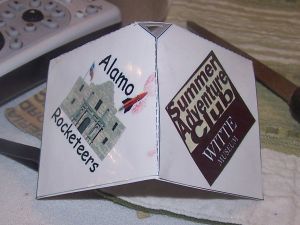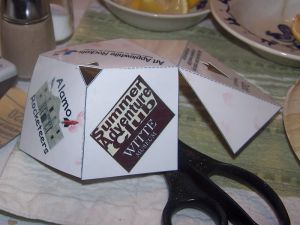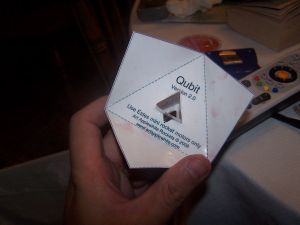Art Applewhite Rockets Qubit 2.0 13mm (Plan)
Art Applewhite Rockets - Qubit 2.0 (13mm) {Kit}
Contributed by John Lee
| Construction Rating: | starstarstarstarstar |
| Flight Rating: | starstarstarstarstar_border |
| Overall Rating: | starstarstarstarstar_border |
| Manufacturer: | Art Applewhite Rockets  |

Brief:
The Qubit 2 is an updating of Art Applewhite's venerable Qubit rocket. The original was intended to fly only on Estes
A10-PTs. Since those are getting hard to come by, Art redesigned and released this version. Like it's predecessor, it
is available as a free download from his site, www.artapplewhite.com.
The Qubit is a high drag rocket that scoots upward, quickly comes to a halt at the end of boost phase and then inverts and recovers by aerobraking.
Construction:
All you need to build the Qubit is a piece of 110# cardstock, a printer, a razor knife, and some white glue.
The build is a simple one. The motor mount is cut out and folded along the dashed lines. After it is folded, it is glued along the tab forming a triangular tube for the motor mount.
Next, the body is cut out. Take your time and use a straightedge to guide the cuts. Once it is cut out, use the razor knife to cut out the holes for the lug and the motor mount. Then carefully crease along the dotted lines.
Glue the tab to form the pyramidal top and then fold under the after bulkhead and glue the "wings" in place. You're almost done.
Slide the motor mount into the provided hole and glue.
PROs: easy, anyone can do it, freeCONs: none
Finishing:
The default finish on the Qubit is whatever color cardstock you print on. Aside from that, you can color it, paint
it, or even decal it as the muse moves you.
I built a bunch of these things for a kids class at the local museum and Art gave me permission to digitally alter the file to put his logo, the club logo, and the museum logo on it.
PROs: limited only by the imagination
CONs: my imagination is lacking


Construction Rating: 5 out of 5
Flight:
This version of the Qubit resembles its 18 and 24 millimeter cousins in that it has an open top to accommodate
ejection gases. As such, it can handle any 13mm motor on the market today.
The one I used for this review was only flown once and that was on a 1/2A3-2T. It went up, turned over, and came down slowly, all as expected.
The class I was teaching launched 17 more, each 2 times. The first was on the 1/2A as per above and the second was on an A10-3T. It was the same only higher and with more acceleration.
Several of the class volunteered their rockets for an experiment. We loaded a rack consisting of 1/4A3-3T, 1/2A3-2T, A3-2T, and A10-3T. They were launched simultaneously and the results were pretty much what you would expect with the A3 being the altitude winner. Even the 1/4A made a respectable showing although the ejection charge went off only inches from the ground.
These rockets were made by little hands from the 3rd through the 5th grades. That meant that some were more "symmetrical" than others and it showed in the flights. Even so, all were safe and the kids had a great time.
PROs: practically foolproof
CONs: none
Recovery:
Recovery is just a matter of the rocket turning over and using aerodynamic drag to slow itself. It is not really a
"tumble" in that it stays oriented as designed and aerobrakes like some real spacecraft.
PROs: its hard to mess up, it does no damage even when you do mess up
CONs: none
Flight Rating: 4 out of 5
Summary:
This is a great teaching tool that is very cost effective. Its hard to beat free. Its looks are out of the ordinary
and it can be launched from a small field. Mainly, it's fun.
Overall Rating: 4 out of 5
 |
 |
Flights
Sponsored Ads
 |
 |











